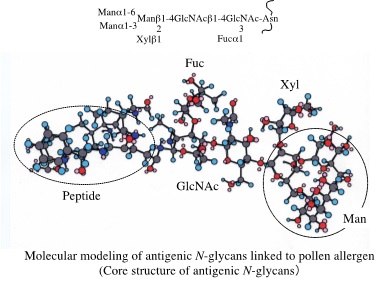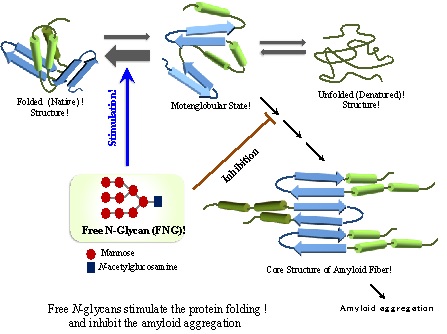Functional Glycobiochemistry
Biochemical research on the biofunction of sugar chains: the third class of essential biopolymers
Staff
Research Topics
Glycan (sugar chain or oligosaccharide), as well as nucleic acid (DNA/RNA) and protein, is one of essential biomolecules involved in various biological processes. From yeast or fungus to human, eukaryotic cells produce a large variety of glycans and often covalently couple these glycans to proteins or lipids. The resulting glycoconjugates, such as glycoproteins and glycolipids, play many critical roles in the development or growth of multicellular organisms (animals, plants and insects), and the glycan moieties are relevant to many human health issues and diseases, including viral infection, allergy, and cancer. The research goal of our laboratory is to unravel the latent biofunctions of glycans and apply the decoded glycan-functions to the development of new glycodrugs, functional foods, and plant breeding.
Plant glycobiology
・Functional analysis of oligosaccharides involved in plant differentiation, growth, and fruit maturation.
・Development of new glycotechnology on plant breeding through genetic manipulation of glycogenes involved in glycan metabolism.
 In developing hypocotyls, seeds, and fruits at the maturing stage, free N-glycans (FNG) released from glycoproteins or glycopeptides occur at micro molar concentration. We analyze (1) the biofunctions of FNs involved in plant differentiation, growth, and fruit maturation, (2) chaperon-like functions involved in the protein-folding or -refolding mechanism. Based on the unraveled of the biofunctions of FNGs, we aim to establish a new plant biotechnology to control plant differentiation, growth, and fruit-maturation through artificial regulation of the expression of glycogenes (glycosidases, glycosyltrasferases, and glycan-liberating enzymes). |
Glycoimmunolgy
・Analysis of the immunological activities of antigenic glycans of plant or insect origin
・Application of their immunoactivies to the development of glycodrugs.
 In many case, allergens of plant or insect origin are glycoproteins to which antigenic glycans are linked and these allergens are often referred as glycoallergens. We analyze the chemical structures and immunological activities of these plant glycoallergens. Recently, we have found that plant antigenic glycans suppress the production of Th2 type cytokine, IL-4, from Th2 immune cells. For the application of immunological activity of these plant glycans to the development of glycodrugs, we analyze their cellular immunological activities and synthesize neo-glycopolymers carrying the immunoactive glycans. |
Glycotechnology
・Analysis of in vivo / in vitro functions of free N-glycans (FNGs) responsible for correct protein folding and refolding
・Application of the chaperon-like functions of FNGs to the development of glycoreagent stimulating protein correct folding.
 In plant and animal cells or tissues, the liberated asparagine-linked glycans (free N-glycans, FNG) ubiquitously occur. Recently we have found that these FNGs induce the correct protein folding or refolding of denatured or misfolded proteins at millimolar concentration. We analyze the chaperon-like activity of FNGs involved in the protein quality control system working in eukaryotic cells using biochemical and physiochemical strategies. We aim to establish a new concept of glycan function responsible for correct protein folding and apply the chaperon-like function to the development of glycol-reagents stimulating the correct construction of protein 3D structures. |
Publication List
- Direct evidence of cytosolic PNGase activity in Arabidopsis thaliana: in vitro assay system for plant cPNGase activity. Shirai, S., Uemura, R., Maeda, M., Kajiura, H., Misaki, R., Fujiyama, K., Kimura, Y. Biosci Biotechnol Biochem. doi: 10.1093/bbb/zbab047 (2021).
- Cytosolic Free N-Glycans Are Retro-Transported Into the Endoplasmic Reticulum in Plant Cells. Katsube, M., Ebara, N., Maeda, M., Kimura, Y. Front Plant Sci.,11, doi: 10.3389/fpls.2020.610124 (2020).
- Convenient preparation of an antigenic oligosaccharide from white kidney bean powder: A useful plant oligosaccharide for synthesis of immunoactive glycopolymer. Kimura, M., Ogura, M., Akamatsu M., Sugimoto K., Maeda, M., Nitoda T., Nagasawa-Fujimori, H., Yamashita H., Kimura Y. Int. J. Biol. Macromol. 153, 1016-1023 (2020).
- Synthesis and preliminary evaluation of neoglycopolymers carrying multivalent N-glycopeptide units. Takeda, N., Maeda, M., Itano, S., Takase, M., Kimura, M., and Kimura Y. Int. J. Biol. Macromol. 147, 1294-1300 (2020).
- Plant complex type free N-glycans occur in tomato xylem sap. Biosci. Biotechnol. Biochem. 83, 1310-1314 (2019).
- Molecular characterization of second tomato α1,3/4-fucosidase (α-Fuc’ase Sl-2), a member of glycosyl hydrolase family 29 active toward the core α1,3-fucosyl residue in plant N -glycans. Rahman, Md.Z., Tsujimori, Y., Maeda, M., Hossain, Md.A., Ishimizu, T., and Kimura, Y. J. Biochem., https://doi.org/10.1093/jb/mvy029 (2018).
- Novel assay system for acidic Peptide:N-glycanase (aPNGase) activity in crude plant extract. Uemura, R., Ogura, M., Matsumaru, C., Akiyama, T., Maeda, M., and Kimura, Y. Biosci. Biotechnol. Biochem. https://doi.org/10.1080/09168451.2018.1459464 (2018).
- Glycoform of a newly identified pollen allergen, Cha o 3, from Chamaecyparis obtusa (Japanese cypress, Hinoki). Osada, T., Maeda, M., Tanabe, C., Furuta., Vavricka, J. C., Sasaki, E., Okano, M., and Kimura, Y., Carbhydr. Res. 448, 18-23 (2017).
- Molecular characterization of tomato α1,3/4-fucosidase, a member of glycosyl hydrolase family 29 involved in the degradation of plant complex type N-glycans. Rahman, Md.Z., Maeda, M., Itano, S., Hossain, Md.A,, Ishimizu, T., and Kimura, Y. J. Biochem., 161, 421-432 (2017).
- Occurrence of plant complex type free N-glycans carrying a single GlcNAc residue at the reducing end in a fresh-water plant, Egeria densa: A possible mechanism for biosynthesis of free N-glycans in plants. Maeda, M., Ebara, N., Tani, M., Vavricka,, J. C., and Kimura, Y. Glycoconj. J. 34, 229-240 (2017).
